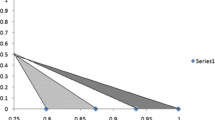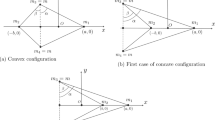Abstract
This paper focuses on the study of a new type of a planar, circular restricted three-body problem with an attractive artificial electrostatic field (E-field) at collinear libration points. For instance, this attractive field can be generated by an orbiting spacecraft located at the Mars-Phobos L1 libration point and an electrostatic capsule launched from Phobos. The feasibility of the proposed retrieval system is discussed from the aspect of local space weather Debye length. The attractive E-field splits the collinear libration point into two new collinear points, and the greater the E-field potential and the Debye length the greater the distance between the new libration points and the “old” original libration point. The new equilibrium positions caused by the action of the E-field have been found, and an instability of these new libration points has been proven. A new Jacobi integral in analytical form is obtained and equations of motion are derived for the restricted problem of three bodies taking into account the E-field. A numerical simulation shows the impact of the E-field potential on capsule capture in the small vicinity of the Mars-Phobos L1 libration point. This work expands the classic three-body problem filling with new content. The obtained results can be applied, for example, to study an opportunity of delivering the Phobos samples using Coulomb interaction of bodies in space.



Similar content being viewed by others
References
Szebehely, V.: The Restricted Problem of Three Bodies. Academic Press Inc., New York (1967)
Connor Howell, K.: Three-dimensional, periodic, ‘halo’ orbits. Celestial Mech. 32, 53–71 (1984). https://doi.org/10.1007/BF01358403
Luo, T., Pucacco, G., Xu, M.: Lissajous and halo orbits in the restricted three-body problem by normalization method. Nonlinear Dyn. 101, 2629–2644 (2020). https://doi.org/10.1007/s11071-020-05875-1
Zotos, E.E.: Classifying orbits in the restricted three-body problem. Nonlinear Dyn. 82, 1233–1250 (2015). https://doi.org/10.1007/s11071-015-2229-4
Ferrari, F., Lavagna, M.: Periodic motion around libration points in the elliptic restricted three-body problem. Nonlinear Dyn. 93, 453–462 (2018). https://doi.org/10.1007/s11071-018-4203-4
Woo, P., Misra, A.K.: Equilibrium points in the full three-body problem. Acta Astronaut. 99, 158–165 (2014). https://doi.org/10.1016/j.actaastro.2014.02.019
Biggs, J.D., Negri, A.: Orbit-attitude control in a circular restricted three-body problem using distributed reflectivity devices. J. Guid. Control Dyn. 42(12), 2712–2721 (2019). https://doi.org/10.2514/1.G004493
Alessi, E.M., Sánchez, J.P.: Semi-analytical approach for distant encounters in the spatial circular restricted three-body problem. J. Guid. Control Dyn. 39(2), 351–359 (2016). https://doi.org/10.2514/1.G001237
Shibata, T., Bennett, T., Schaub, H.: Prospects of a hybrid magnetic/electrostatic sample container retriever. J. Spacecraft Rockets 57(3), 434–445 (2020). https://doi.org/10.2514/1.A34509
Dankanich, J., Klein, E.: Mars ascent vehicle development status, IEEE Aerospace Conference, Big Sky. USA (2012). https://doi.org/10.1190/AERO.2012.6187295
Schaub, H., Junkins, J.: Analytical Mechanics of Space Systems, AIAA EducationSeries, 2nd edn. Reston, VA (2009)
Roy, A.E.: Orbital motion. IoP, Bristol and Philadelphia (2005)
Hartzell, C.M., Farrell, W., Marshall, J.: Shaking as means to detach adhered regolith for manned Phobos exploration. Adv. Space Res. 62(8), 2213–2219 (2018). https://doi.org/10.1016/j.asr.2017.09.010
Martynov, M.B., et al.: Planetary protection principles used for Phobos-Grunt mission. Sol. Syst. Res. 45–7, 593–596 (2011). https://doi.org/10.1134/S0038094611070185
Acknowledgements
This study was supported by the Russian Science Foundation (Project No. 19-19-00085).
Author information
Authors and Affiliations
Corresponding author
Ethics declarations
Conflict of interest
The author declares that he has no conflict of interest.
Additional information
Publisher's Note
Springer Nature remains neutral with regard to jurisdictional claims in published maps and institutional affiliations.
Rights and permissions
About this article
Cite this article
Aslanov, V.S. A splitting of collinear libration points in circular restricted three-body problem by an artificial electrostatic field. Nonlinear Dyn 103, 2451–2460 (2021). https://doi.org/10.1007/s11071-021-06226-4
Received:
Accepted:
Published:
Issue Date:
DOI: https://doi.org/10.1007/s11071-021-06226-4




